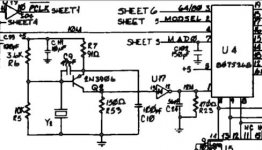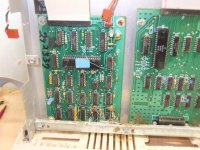pjhacnau
Experienced Member
For the first time in 5+ years I powered up my TRS80 Model IV. Given the time period since last use I was fully prepared to have nothing happen or, worse, some black smoke escaping. To my pleasant surprise, the drives started whirring, and up came the "Diskette?" prompt. I can also break into the Model III prompts and get to a basic prompt. Only problem was the vertical hold being out. No problem thinks I there's an adjuster for that on the bottom side (or is that just contrast I think now after the fact?). Completely failing to remember where it is I turn off and (very gently) turn the computer on its side. Thusly located I put the computer upright and power on again. And now it's not working  Instead of spinning indefinitely the disks spin for about 5 seconds and stop. Nothing on the screen.
Instead of spinning indefinitely the disks spin for about 5 seconds and stop. Nothing on the screen.
I've opened it up and done a quick inspection and there's nothing obviously wrong. The screen is getting power; turning up the brightness fully shows thin scan lines. The two fuses (that I'm aware of) are intact. No bulged/leaking capacitors anywhere.All the point fixes on the main MB appear connected (though I haven't done a serious check there).
So my two questions at this point are:
TIA.
I've opened it up and done a quick inspection and there's nothing obviously wrong. The screen is getting power; turning up the brightness fully shows thin scan lines. The two fuses (that I'm aware of) are intact. No bulged/leaking capacitors anywhere.All the point fixes on the main MB appear connected (though I haven't done a serious check there).
So my two questions at this point are:
- Can someone suggest what the next step is to track this down,
- Is the vertical hold adjusted off the extenal adjustor or, (as I'm thinking now) off the four pots on the board driving the CRT?
TIA.



